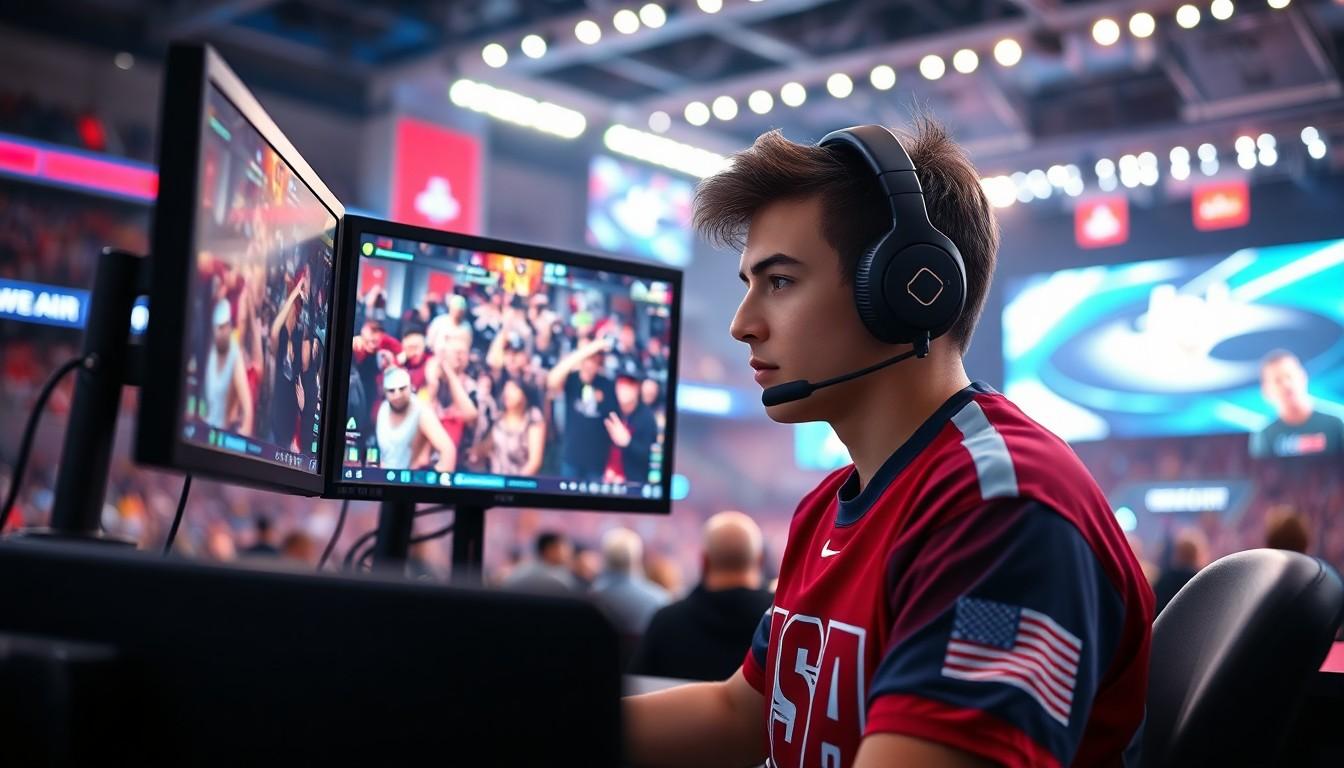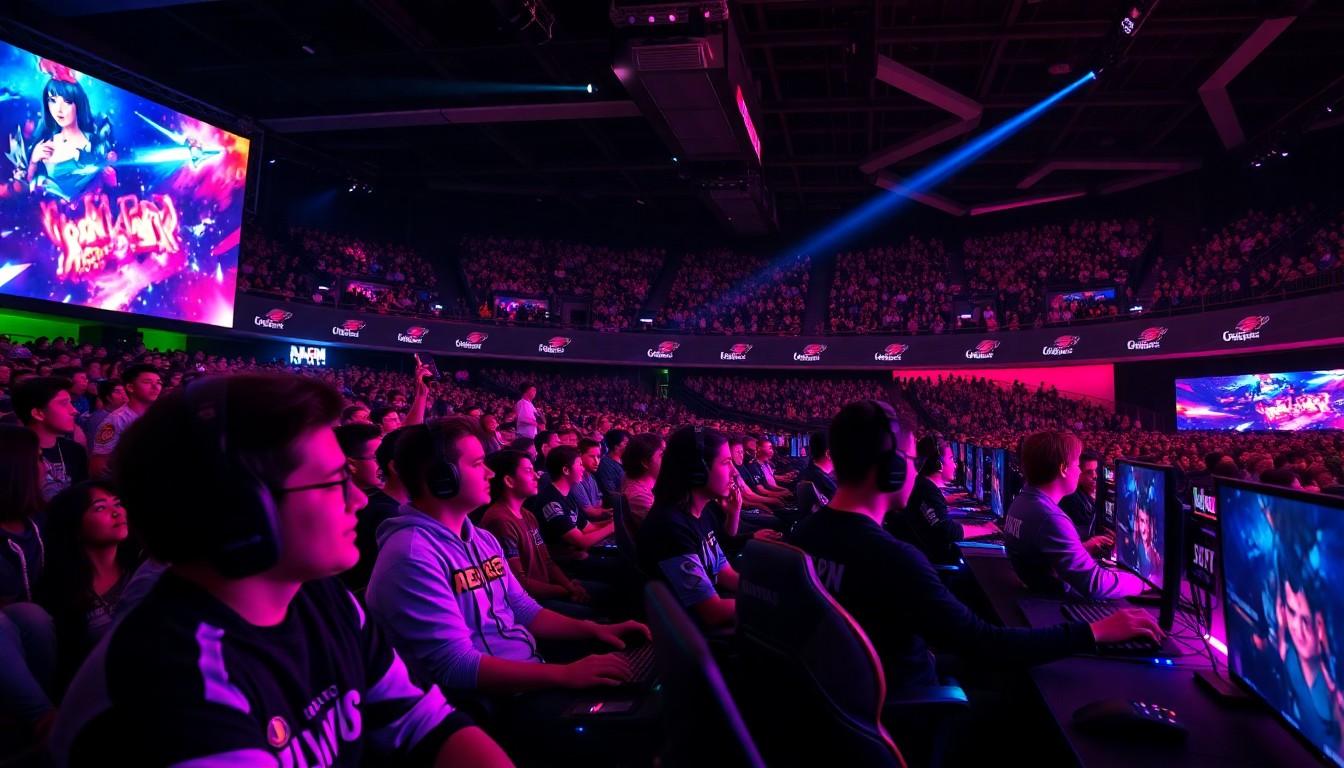Phone:
(701)814-6992
Physical address:
6296 Donnelly Plaza
Ratkeville, Bahamas.

In a world where video games have evolved from basement hobbies to billion-dollar industries, competitive esports is the new frontier. Imagine athletes, not just sweating it out on the field, but also battling it out in virtual arenas, showcasing skills that would make even the most seasoned gamers green with envy. With millions of fans glued to their screens, esports isn’t just a pastime—it’s a global phenomenon.
Competitive esports represents a rapidly growing segment of the global entertainment industry. This field includes organized multiplayer video game competitions, often featuring professional players and teams. These events take place in various formats, such as league play, tournaments, and arena shows. Major titles like League of Legends, Dota 2, and Counter-Strike: Global Offensive attract large audiences, showcasing the skill and strategy involved in high-level gameplay.
Audience engagement for esports events has surged in recent years. Millions tune in to watch live streams on platforms like Twitch and YouTube. Fans follow their favorite players and teams, contributing to a vibrant community online. Revenue generated from sponsorships, merchandise sales, and ticket sales has grown significantly, with estimates predicting the esports market could reach $1.8 billion by 2022.
Esports athletes dedicate countless hours to practice and competition. Training routines often resemble traditional sports, emphasizing teamwork, communication, and individual skill. Coaches and analysts provide support and strategies to improve performance. With increased visibility, esports now offers players opportunities for endorsements and careers beyond gameplay.
Diverse demographics are represented within the esports audience. Viewers range from teens to adults, across various backgrounds and interests. This broad appeal contributes to the industry’s expansion and validates its status as a mainstream pastime.
As competitive esports continues to evolve, technology plays a key role. Advances in streaming capabilities enhance the viewing experience. Cutting-edge graphics and hardware elevate game performance, captivating audiences. Ultimately, the landscape of competitive esports reflects a dynamic intersection of technology, entertainment, and sportsmanship.

Competitive esports began as a small community activity where enthusiasts gathered to showcase their gaming skills.
The origins trace back to the early 1970s with simple arcade games like Pong and Space Invaders. Tournaments held in college campuses laid the foundation for organized competitions. The first significant esports event occurred in 1980, featuring the game Space Invaders at Stanford University, attracting around 10,000 participants. This marked a pivotal moment as gaming shifted from casual play to organized competition. By the mid-1990s, multiplayer games began to emerge, further fostering the competitive scene, leading to the creation of leagues and tournaments for titles like Quake and StarCraft.
In the 2000s, the rise of streaming platforms such as Twitch revolutionized esports viewership. Millions tuned in to watch professional players compete in high-stakes matches, amplifying interest. Title popularity surged, with games like League of Legends and Dota 2 breaking records for audience engagement. Revenues from advertising, sponsorships, and merchandise soared, reflecting the growing significance of esports. The expansion of major tournaments, like The International, awarded multi-million dollar prize pools, solidifying professional gaming as a lucrative career choice. Consequently, competitive esports evolved into a global phenomenon, capturing the attention of mainstream media and large audiences.
Competitive esports features a variety of popular game genres, each attracting dedicated player bases and massive audiences.
MOBA games stand out in the esports landscape, with titles like League of Legends and Dota 2 leading the charge. League of Legends boasts over 180 million active players, and its annual World Championship draws millions of viewers globally. Dota 2, known for its complex gameplay, hosts The International, which regularly offers prize pools exceeding $40 million. Top teams often compete in leagues throughout the year, emphasizing teamwork and strategy. A diverse range of characters allows for unique gameplay experiences, maintaining high player engagement and fan interest. Spectators appreciate the strategic nature of these games, contributing to their growing popularity and significance in competitive esports.
First-person shooter games capture a robust segment of the esports arena. Titles such as Counter-Strike: Global Offensive and Call of Duty attract millions of dedicated fans. Counter-Strike consistently ranks among the favorites, with major tournaments like ESL One and Major Championships boasting significant prize pools and high viewership. Call of Duty features various competitive events, including the Call of Duty League, which showcases team-based gameplay and skill. Availability on multiple platforms broadens the audience reach, enhancing community accessibility. Dynamic gameplay and skill requirements make FPS games thrilling to watch, leading to passionate fan engagement and extensive media coverage.
The esports ecosystem consists of professional teams, players, tournaments, and leagues, all contributing to the industry’s rapid growth. This interconnected structure fosters competitive gaming on a global scale.
Professional teams and players form the backbone of competitive esports. More than 200 organizations compete internationally, including teams like Team Liquid and Fnatic. Players dedicate countless hours to practice, honing their skills to excel in major titles such as League of Legends and Dota 2. Each player often specializes in a specific role, strategically enhancing team dynamics. The average earnings for top esports athletes reach $1 million annually, showcasing the financial viability of this career. Highly skilled individuals can achieve recognition and fame, often becoming brand ambassadors for sponsors and gaming products.
Tournaments and leagues drive competitive gameplay, showcasing top-tier talent and strategies. Major events, like The International and League of Legends World Championship, attract millions of viewers and provide prize pools exceeding $40 million. Professional leagues, such as the Overwatch League, offer structured schedules and regular matchups for teams. These events engage fans through live streaming platforms like Twitch and YouTube, fostering a sense of community. Attendance has soared at live events, with some tournaments selling thousands of tickets. The increasing number of sponsors represents the growing commercial interest in esports, further solidifying its place in the global entertainment landscape.
Competitive esports influences various sectors, including the economy and social dynamics, showcasing its importance in contemporary culture.
Competitive esports generates significant economic growth. By 2022, the esports market reached an estimated value of $1.8 billion. Revenue streams such as sponsorships, ticket sales, and merchandise contribute greatly to this figure. Brands recognize the potential, investing heavily in teams and events. Professional teams grow, and salary structures rise, with top players earning around $1 million annually. Furthermore, major events like The International and League of Legends World Championship draw millions, bolstering local economies through tourism and engagement. In addition, companies related to production, broadcasting, and technology experience growth as they support the esports infrastructure. The ecosystem thrives, creating jobs and opportunities across various fields.
Competitive esports wields substantial social influence. This phenomenon engages a diverse audience, from teens to adults, fostering community around shared interests. Individuals form connections through online platforms like Twitch and YouTube. Viewership numbers reach millions, illustrating the appeal of live events and streaming. Additionally, esports promotes teamwork, strategy, and communication skills within players. The popularity of esports inspires educational initiatives, incorporating gaming into curriculum to teach valuable skills. Many organizations also use gaming to promote social issues, raising awareness through tournaments and streaming events. Overall, competitive esports shapes social interactions, uniting people and expanding networks.
Competitive esports has firmly established itself as a cornerstone of modern entertainment. Its evolution from casual gaming to a billion-dollar industry showcases not only the skill of its athletes but also the dedication of fans worldwide. With major tournaments drawing millions and substantial prize pools, the excitement surrounding esports continues to grow.
As the industry expands, it fosters community engagement and drives economic growth. The blend of technology and entertainment enhances both player performance and viewer experience. Esports isn’t just a trend; it’s a cultural phenomenon that unites diverse audiences and shapes the future of competitive gaming.